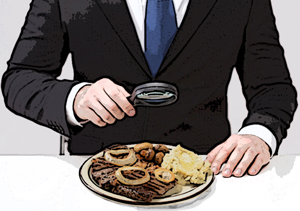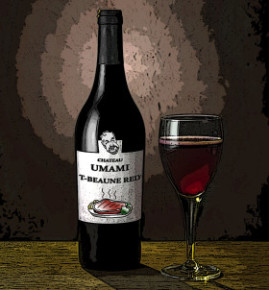In Search Of Umami.
Chapter Eight, Parts One & Two.
Where Have You Been All My Life?
 Sweet, sour, salt, bitter … sweet, sour, salt, bitter. I repeated those words at so many events for so many years that the phrase was like my own personal mantra, rooted in my psyche by daily visits to the Deli Lama. Just imagine my concern when I learned of umami – the existence of a fifth taste was surely going to throw off my mantra rhythm. Sweet, sour, salt, bitter … UMAMI? It has a good beet but you just can’t trance to it.
Sweet, sour, salt, bitter … sweet, sour, salt, bitter. I repeated those words at so many events for so many years that the phrase was like my own personal mantra, rooted in my psyche by daily visits to the Deli Lama. Just imagine my concern when I learned of umami – the existence of a fifth taste was surely going to throw off my mantra rhythm. Sweet, sour, salt, bitter … UMAMI? It has a good beet but you just can’t trance to it.
Not only did this secretive fifth taste exist, it existed right under my nose – where my mouth is conveniently located. I knew if I was ever going to get my mantra groove back I needed to embrace the mystical taste I’d overlooked for so long. I gathered articles and books on the subject and soon learned that describing the taste of umami is like describing the flavor of wine, it’s just so many words on a page. Umami, like wine, must be experienced to be understood.
My research reminded me of a passage in Kurt Vonnegut’s God Bless You Mr. Rosewater in which insurance salesman Fred Rosewater, in an attempt to appear manlier to fisherman Harry Pena, points to a picture of a bikini-clad girl in a magazine.
“Like that Harry?” he asked.
“Like what?”
“The girl there.”
“That’s not a girl. That’s a piece of paper.”
“Looks like a girl to me.” Fred Rosewater leered.
“Then you’re easily fooled,” said Harry. “It’s done with ink on a piece of paper. That girl’s not lying there on the counter. She’s thousands of miles away, doesn’t even know we’re alive. If this was a real girl, all I’d have to do for a living would be to stay home and cut out pictures of big fish.”¹
Rather than stay home and cut out pictures of umami rich foods, I decided to get off the couch and experience umami as it was meant to be experienced, at the end of a fork. No sacrifice was too great to make for this blog, and after two months and eight pounds, I succeeded in expanding my understanding of umami nearly as much as my waistline.
It’s time for you to get off the couch, pick up a fork and experience real umami for yourself because reading about it is, as Harry Pena said to Fred Rosewater, just “ink on a piece of paper.”
Wait! Don’t go yet. Finish reading this post so you know what you’re looking for.
I’ll Have the T-Beaune
To really know umami you must first acclimate your palate to its subtle characteristics and then work at recognizing it through repetition. In The Fifth Taste, Cooking With Umami, David and Anna Kasabian present a simple recipe to help identify umami. They suggest you boil one tablespoon of dried shiitake mushrooms² in a cup of water, let it cool and taste it while holding your nose. When I tried this exercise I couldn’t taste anything at all (and breathing was no picnic either). That is until I released my nose and tasted … well, mushrooms.
Disappointed, I upped the dose and tried again. Nothing.
I checked the packaging for an expiration date and there on the label in capital letters was the solution; NEVER EAT DRIED MUSHROOMS RAW. I popped one into my mouth. I pondered the unpleasant taste and thought, “Maybe some sacrifices are too great for this blog.” This research was going to be harder than I thought.
Undaunted, my search for umami illumination led me to the umami mountaintop. Gary Beauchamp, PhD, is the director of the Monell Chemical Senses Center in Philadelphia, and a leading authority on umami. In 2010 I asked Dr. Beauchamp how to taste umami in its purest form.
“The best way to experience umami” he replied, “is to purchase Accent (I think it is still sold). This is essentially pure MSG, the prototypical umami stimulus. If you dissolve this in plain water and taste it, it will be salty plus umami.”
Once again I had to decide how much I was willing to sacrifice for this blog but I did as Dr. Beauchamp suggested and (surprise!) I found it to be an altogether unpleasant experience. The salty taste initially overwhelmed any other flavor that might have been lurking in my Accent cocktail, but I soon noticed a familiar taste develop along the sides of my tongue, where my personal umami taste sensors are installed.
To reinforce the perception I placed a spoonful of pure MSG in my mouth (don’t worry, the doctor says the twitching will stop once the swelling goes down). Again it took a few seconds for the salty characteristic to fade but then a familiar beefy, broth-like taste emerged, reminiscent of strong beef bouillon. It seemed to put on weight in my mouth, developing a rich viscosity and creating a sensation that was more texture than flavor.
 The sensation lingered on my palate for several minutes, much like a great wine. In an MSG-induced delirium I thought, “I should create a new wine targeting umami aficionados. I’ll make it from beef and call it T-Beaune Red or Cabernet SauvMignon!”
The sensation lingered on my palate for several minutes, much like a great wine. In an MSG-induced delirium I thought, “I should create a new wine targeting umami aficionados. I’ll make it from beef and call it T-Beaune Red or Cabernet SauvMignon!”
When I completed my MSG detox and could once again get my shoes on I thought about the various descriptions I’d read for the taciturn taste of umami and one term seemed particularly fitting – this taste was savory. David and Anna Kasabian wrote, “Umami … is not hard to describe. No harder, really, than describing sweet, sour, salty, or bitter. Among the most apt descriptors are savory, mouth-filling, brothy, meaty, satisfying, and rich” which is everything I’ve ever wanted in a spouse.
The term umami (pronounced oo-MOM-ee) comes from the Japanese umai meaning delicious, and mi meaning essence. I’d finally discovered this delicious essence in a spoonful of MSG and was on the road to umami enlightenment but something was bothering me. The taste I had worked so hard to uncover didn’t taste very delicious to me.
Dr. Beauchamp revealed that this is a common reaction to umami, adding, “Research shows that people do not like umami alone – it must go with other flavors.” The Kasabians wrote, “Like salt, it isn’t all that pleasant by itself, but it makes other foods taste much better, sometimes turning the nearly unpalatable into a rewarding feast.”
Once I became proficient at recognizing umami, it dawned on me that I’ve been experiencing it my whole life (I read somewhere that mothers milk is full of it). I remembered once tasting umami in a bottle of Bordeaux. The earthy flavor of the wine was reminiscent of wild mushrooms, which is not an uncommon flavor in Bordeaux, but in this particular bottle I found it strong and off-putting.
I thought there might be something wrong with the wine so I asked the sommelier “Was this wine imported from France?”
 “Why of course it was. Why do you ask?”
“Why of course it was. Why do you ask?”
“Because it tastes like it was deported from France.”
Unruffled, he replied, “If you don’t like this wine it’s probably because you don’t like umami.”
“Listen Freud,” I said, “You leave her out of this.”
¹Vonnegut, K. (1965) God Bless You Mr. Rosewater, 153
²Dried mushrooms are higher in umami than fresh mushrooms. The package I purchased stated one ounce of dried mushrooms is approximately equivalent to eight ounces of fresh mushrooms.





















Oooh, mommy that was a great read! Really, all kidding aside, it was!
I hope you found it savory, meaty, satisfying and rich.
I had no idea there was a fifth taste. Will there be a Part 3 & 4?
Don’t miss the next blog for more tasteless writing about taste!